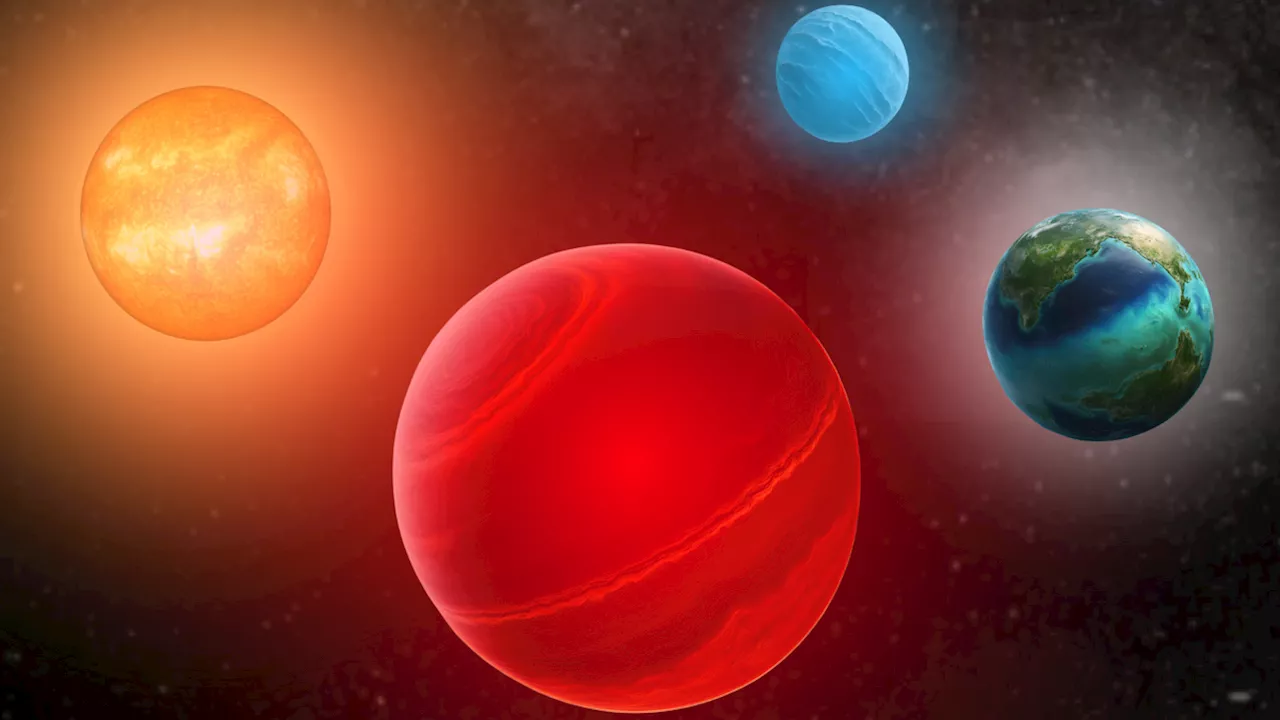A new study led by the University of Geneva (UNIGE) has revealed the existence of a planetary system, WASP-132, with an unexpected architecture. This system not only contains a Hot Jupiter but also an inner Super-Earth and an icy giant planet, challenging previous theories about the migration of giant planets.
Hot Jupiters are giant planets initially known to orbit alone close to their star. During their migration towards their star, these planets were thought to accrete or eject any other planets present. However, this paradigm has been overturned by recent observations, and the final blow could come from a new study led by the University of Geneva (UNIGE).
A team including the National Centre of Competence in Research (NCCR) PlanetS, the Universities of Bern (UNIBE) and Zurich (UZH) and several foreign universities has just announced the existence of a planetary system, WASP-132, with an unexpected architecture. It not only contains a Hot Jupiter but also an inner Super-Earth and an icy giant planet. These results are published in Astronomy. Hot Jupiters are planets with masses similar to that of Jupiter, but orbit close to their star, at a much smaller distance than Mercury is to the Sun. It is difficult for these giant planets to form where they are observed, because there is not enough gas and dust close to the star. They must therefore form far from it and migrate as the planetary system evolves. Until recently, astronomers observed that Hot Jupiters were isolated around their star, with no other planets in their vicinity. This observation seemed all the more solid as there was a theory to explain it. The processes involved in the migration of giant planets towards their star lead to the accretion or ejection of any planets in an inner orbit. But recent observations suggest other scenarios. A team led by the Astronomy Department of the UNIGE Faculty of Science, in partnership with UNIBE and UZH, as part of the NCCR PlanetS, and with other international institutions such as the University of Warwick, has just confirmed this trend. The scientists have discovered the existence of a multi-planetary system made up of a Hot Jupiter, an inner Super-Earth (even closer to the star than the hot Jupiter) and an outer massive giant planet (much further away from the star than the Hot Jupiter). If Hot Jupiters are not always alone in their planetary system, then their migration process must be different in order to preserve the architecture of the system. The WASP-132 system is a unique multi-planetary system. It contains a Hot Jupiter that orbits its star in 7 days and 3 hours; a Super-Earth (a rocky planet 6 times the mass of the Earth) that orbits the star in just 24 hours and 17 minutes; and a giant planet (5 times the mass of Jupiter) that orbits the host star in 5 years. In addition, a much more massive companion, probably a brown dwarf (a celestial body whose mass is between that of a planet and that of a star), orbits at a very long distance. 'The WASP-132 system is a remarkable laboratory for studying the formation and evolution of multi-planetary systems. The discovery of a Hot Jupiter alongside an inner Super-Earth and a distant giant planet calls into question our understanding of the formation and evolution of these systems,' says François Bouchy, associate professor in the Department of Astronomy at the UNIGE Faculty of Science and co-author of the study. 'This is the first time we have observed such a configuration!' adds Solène Ulmer-Moll, a postdoctoral researcher at UNIGE and UNIBE at the time of the study and co-author of the paper. For exoplanetologists, the story of the star WASP-132 began in 2006, as part of the Wide-Angle Search for Planets (WASP) program. In 2012, the accumulation of more than 23,000 photometric measurements made it possible to identify a planetary candidate, WASP-132b, with a radius of 0.87 times Jupiter's and an orbital period of 7.1 days. In 2014, the CORALIE spectrograph, installed on the Swiss Euler telescope and led by the UNIGE, began a campaign to monitor this candidate. In 2016, WASP-132b was confirmed and its mass was measured to be equal to 0.41 Jupiter masses. Furthermore the CORALIE measurements indicate the presence of another giant planet with a very long period. Around the same star, at the end of 2021, the TESS space telescope revealed the signal from a transiting Super-Earth with a diameter of 1.8 Earth radii and a period of only 1.01 days. In the first half of 2022, the HARPS spectrograph at the La Silla observatory measured the mass of this Super-Earth, which is six times the mass of Earth, as part of a program led by David Armstrong from the University of Warwick.
PLANETS HOT JUPITERS SUPEREARTH PLANETARY SYSTEMS WASP-132
United States Latest News, United States Headlines
Similar News:You can also read news stories similar to this one that we have collected from other news sources.
 Darius Garland scores season-high 40 points, Cavaliers beat Raptors 132-126 for 12th straight winMobley goes for 21 and 11
Darius Garland scores season-high 40 points, Cavaliers beat Raptors 132-126 for 12th straight winMobley goes for 21 and 11
Read more »
 Darius Garland scores season-high 40 points, Cavaliers beat Raptors 132-126 for 12th straight winEvan Mobley finished with 21 points, 11 rebounds and six assists for the Cavaliers, who are tied for the fifth-best record in league history through 37 games at 33-4.
Darius Garland scores season-high 40 points, Cavaliers beat Raptors 132-126 for 12th straight winEvan Mobley finished with 21 points, 11 rebounds and six assists for the Cavaliers, who are tied for the fifth-best record in league history through 37 games at 33-4.
Read more »
 Multi-Planet System Challenges Hot Jupiter TheoriesA newly discovered system with two planets, including a 'hot Jupiter', challenges scientists' understanding of how these gas giants form and migrate within planetary systems. The system, centered around the star WASP-132, has a super-Earth orbiting closer to the star than its hot Jupiter sibling, contradicting current theories about hot Jupiter migration.
Multi-Planet System Challenges Hot Jupiter TheoriesA newly discovered system with two planets, including a 'hot Jupiter', challenges scientists' understanding of how these gas giants form and migrate within planetary systems. The system, centered around the star WASP-132, has a super-Earth orbiting closer to the star than its hot Jupiter sibling, contradicting current theories about hot Jupiter migration.
Read more »
 Planetary Visibility Guide for 2025This guide details the best times to observe Mercury and Venus in 2025, including their visibility periods, brightest points, and notable conjunctions.
Planetary Visibility Guide for 2025This guide details the best times to observe Mercury and Venus in 2025, including their visibility periods, brightest points, and notable conjunctions.
Read more »
 Mario Reveals Fun of Performing as The Wasp on 'The Masked Singer'Mario dishes on his experience as The Wasp on 'The Masked Singer', detailing the challenges of singing in the mask and revealing the exciting creative process behind it. He also discusses his new music project and upcoming tour with Mary J. Blige and Ne-Yo.
Mario Reveals Fun of Performing as The Wasp on 'The Masked Singer'Mario dishes on his experience as The Wasp on 'The Masked Singer', detailing the challenges of singing in the mask and revealing the exciting creative process behind it. He also discusses his new music project and upcoming tour with Mary J. Blige and Ne-Yo.
Read more »
![[Spoiler] Says Fans Knew He Was Masked Singer's Wasp Since ‘1st Show’](https://i.headtopics.com/images/2024/12/19/usweekly/spoiler-says-fans-knew-he-was-masked-singer-s-wasp-spoiler-says-fans-knew-he-was-masked-singer-s-wasp-E7EA34BBDACCB19C2959C4568BBE8E05.webp?w=640) [Spoiler] Says Fans Knew He Was Masked Singer's Wasp Since ‘1st Show’The Masked Singer’s Wasp exclusively told Us Weekly that his fans had him clocked as soon as he appeared on the ‘first show’
[Spoiler] Says Fans Knew He Was Masked Singer's Wasp Since ‘1st Show’The Masked Singer’s Wasp exclusively told Us Weekly that his fans had him clocked as soon as he appeared on the ‘first show’
Read more »
